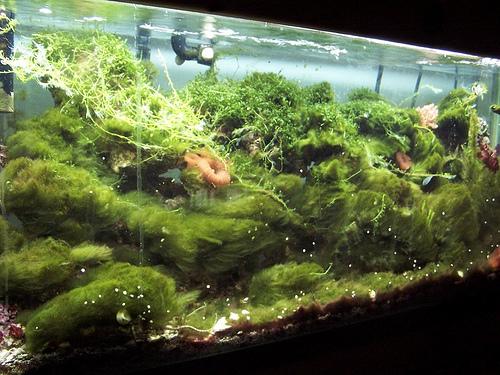Uninvited algae are one of the most irritating problems an aquarist can get stuck with. Not only do they make your tank look unattractive and filthy but also cause nuisance among corals and other anemones. Precaution is always better than cure so before these ugly head algae come to party in tank why not take some preventive measures and keep them from destroying your efforts? Of course you cannot put a “no entry” signboard for it to read and get lost. There are ways that can ensure that your tank remains algae free and some measures to charge these filthy creatures if they ever dare to come in your tank and get them out before they can cause any annoyance.
Brown diatom algae
The first kind of algae that bugs any new aquarist is the brown diatom algae. Especially in reef tanks, you never know how they come to your tank via new liver rocks. The dirty brown bloom crops up because of the curing of the live rock induce silicates and nutrients which are like a treat to these creatures. The spreading of these algae is so fast that soon you will find everything inside your reef tank coated with the brown dirt.
Red slime algae
This nuisance causing algae breaks out on top of the substrate. They look yuck indeed and refuse to go off easily. In the earliest stage when you see these algae in your reef tank, it is necessary that you act immediately to get them cleared else they will grow faster and soon entire constituent of your reef will get infected.
Green hair algae
These algae come to party in your reef tank before of the high intensity lightning to which it loves and then decides to not to leave after the party is over. They refuse to go with scrubs and are too stubborn to leave your tank until it makes your tank filthy. Scrubbing won’t remove it completely so instead resort to the following measures.
1.Protein skimmer
Ensure that your protein skimmer is working properly as it is solely responsible for removing wastes and extra nutrients from your tank. Check frequently to make sure that the venture is not clogged. You can add limewood airstone to enable more bubbling so that the wastes get exported properly. The size of the skimmer also matters in this respect. You must always purchase the skimmer that is apt for the size of your tank. Extra large skimmer or smaller one can cause trouble and won’t help to control algae.
2.Lightning variation
Since high intensity lights are needed for reef tanks to ensure healthy thriving of corals, algae are very prone to infect your tank. It will be safer if you could cut the light intensity to low for a few hours. The tanks that have two types of lightning; a brighter one for the day and a blue one for the night are found to get less infect with algae compared to those that have high intensity light throughout the day. If your tank has already developed algae, you can lessen the lighting to reduce or remove them.
3.Additional nutrients
Adding of trace elements and supplements can promote growth of algae. More than your corals and fishes, these algae will consume the nutrients faster and grow at a rapid rate. When you buy food products for your tanks, go though the ingredients lists precisely and do not buy products that have more of iron content as they will encourage algal growth faster. When a product does not mention the list of ingredients, it is better not to buy them as they might contain elements that will boost algal growth.
4.Water change
Regular water change is necessary to free the tank of unconsumed food and otherwastes on which algae might bloom. Changing water at a regular interval should be maintained strictly. You must also check your water at regular intervals for purity. Substance like phosphate and nitrate content in water can invite algal growth. Test kits are available for these checks. If you find your tap water containing these elements, it is important that you get your water filtered before adding them to tank.
5.Add herbivores
Herbivores like Trochus and Astraea snails are a great add to your reef tank as they will eagerly consume all the algae and free your tank of the nuisance. Nerite snails are also great for this job. For hair algae you can get Hermit crabs that will very soon consume them all and clear your reef tank. You can add some detritivores to clear the wastes in water like unconsumed food that are the main reason for algal bloom. Bristle stars, bristleworms, hermit crabs, Nassarius snails and sea cucumbers will do this job with ease.
Just these precautions and some additions will make your reef tank algae free for a long time. They are undesirable and must be removed soon to prevent them from further deteriorating your tank and making your efforts go unattractive.
The first thing to do is to purchase Trochus or Astraea snails that eagerly consume the brown diatom film. I personally prefer Trochus snails because they seem more robust than the Astraea strain. I’ve had good results purchasing Trochus snails from IPSF. There are other snails that will clean the glass such as Nerite and Strombus snails, but Trochus and Astraea snails are the brown diatom cleaner workhorses.



